UC Gardening Blogs
Peruvian Daffodil
While walking through a local box store, I passed the rack where they had a few flower bulbs still left. So I rummaged through to see what they might have. That's when I found a bag of Peruvian Daffodils; the picture was interesting and since I did not know a thing about this bulb, I had to buy it and take it home.
Once I had it home I opened the bag and found 3 medium-size bulbs in it and very little information about them on the package. So to the Internet I went. What I found is that Peruvian Daffodil, Hymenocallis is not a true daffodil, but it does belong to the daffodil and amaryllis family.
When it did bloom it had a slight fragrance with white blossoms that looked like a large spider, in fact, its common name is “Spider Lily”.
They are a spring blooming plant, the soil should be kept moist not wet, so in the spring watering one a week should work. Fertilizer will encourage them to spread. If you are lucky enough to have several come up in the spring, after blooming and the leaves die back, they should be separated so they don't get overcrowded, otherwise, they will not bloom. They grow about 24 inches tall and can spread 6-12 inches wide. If you decided to dig them up in the fall, be sure to keep the bulbs where children and pets can't get to them as the bulbs are poisonous.
If they do propagate, next spring I hope to have more than the 3.
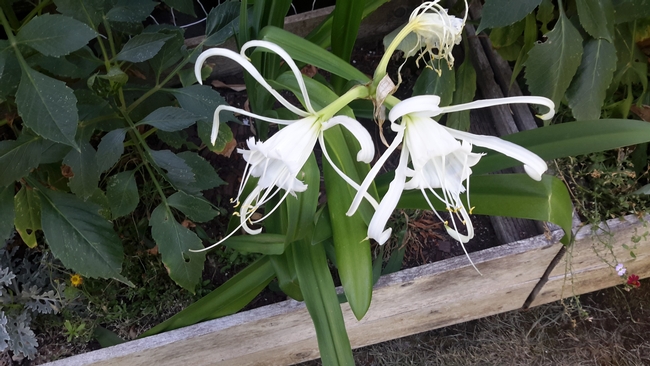
Peruvian Daffodil pic
Ladybug Assault
I had heard from many sources over the years that ladybugs can solve an aphid infestation. I have always had seasonal attacks but with a little water spraying, they were discouraged so it never seemed necessary to call in the big guns. In retrospect, I realize how modest my aphid numbers have been in the past. For some reason, this year was different. It was like a plague of biblical proportions. It must have had something to do with the jerky springtime and the microenvironment of my garden because my house blocks big wind coming from the front but not from the back. And it is the backyard that is under siege, especially the roses. Aphids don't seem to like many of the other flowering annuals I have in my garden.
My first thought, as usual, was to try a stiff shot of water. But I think the aphids took it as food. They were incredibly thick to the point that it was like a coating; as if I had painted the buds with these insects. Trying to stick to good IPM principles, I tried insecticidal soap. To no avail. I thought of getting more serious medicine after the little devils, but I was reluctant to use big guns, like insecticide. I dragged whatever I could get with my fingers, but as you can imagine that was of no long-term help. I was also beginning to worry about using too much water spraying since it looks like a dry summer may be our fate this year and I didn't want to contribute to water wastage for the vanity of having beautiful roses. I began to cut off the infested buds and stems, feeling like I was heading for a dismal summer.
As my despair turned to futility, I noticed a ladybug on one of the plants. Just how much could one bug consume, I thought. Within a couple of days, however, the ladybug visitation had grown considerably. At the height of the night-march of the ladybug cavalry, the plant had almost as may good bugs as bad. The bushes were literally weighed down with them – ceaselessly feasting on the aphids. I also bought a container of ladybugs packaged for this purpose. They joined in right away. It took barely a day of their voracious eating for me to be able to see the actual buds and stems again. After a couple of days, the major numbers of the good guys had moved off to another location but they did leave behind a small number of clean–up scouts to clear up the remaining bad bugs. But now the numbers were reduced enough that I could get them off with a good water spray. And I had renewed hope that the buds would open up.
The thing I learned the most from this whole encounter is the value of patience. I wasn't convinced that the good guys (or ladies, in this case) would win since they were so outnumbered. And also, once they started coming, the ladybugs swarmed in large numbers and stayed until their job was done. Nature is humbling.
Being relatively new to gardening, I had never witnessed nature taking care of itself so dramatically in my behalf. I was automatically reaching for a chemical solution and was really impressed by how the roses-aphids-ladybugs worked together at their own pace to fix the problem. I think that black spot will prove a tougher battle, but since there is really so little that I can do about it, I am trying patience to see how nature solves this one. My job seems to be to throw out the hopelessly damaged leaves and keep my fingers crossed.
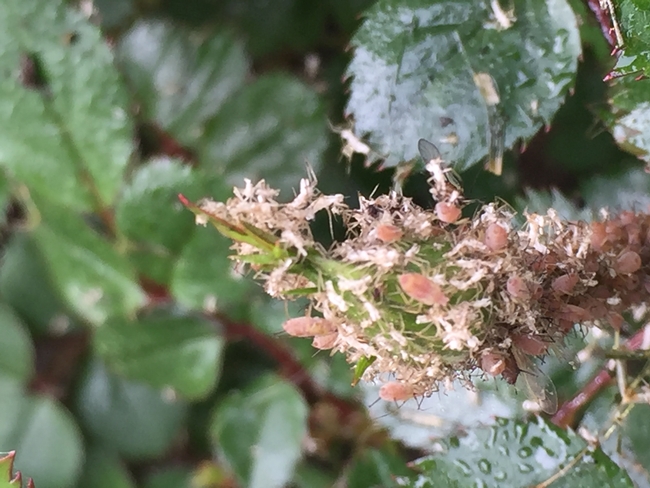
photos by Jennifer Baumbach
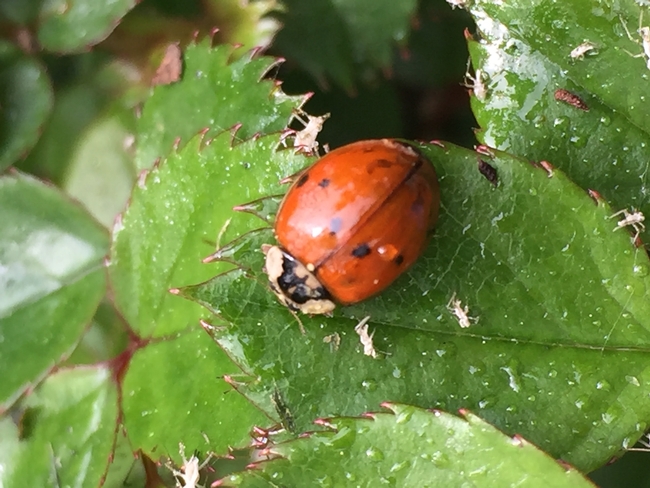
IMG 0067
About Those Declining Meadow Spittlebugs along the California Coastlne...
Who knew they were declining? Well, ecologists Richard "Rick" Karban Mikaela Huntzinger of the UC...
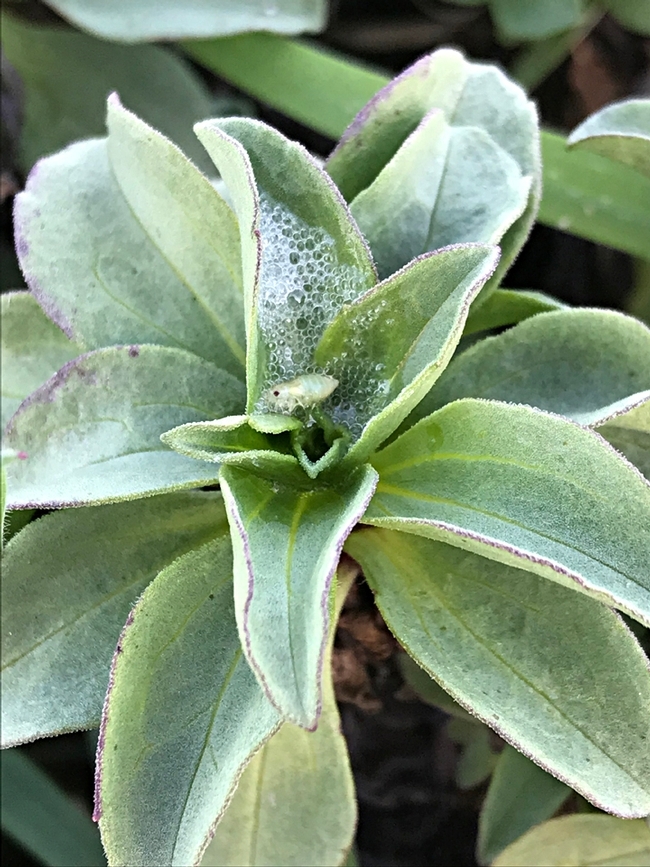
A meadow spittlebug nymph at the Bodega Marine Reserve. (Photo by Mikaela Huntzinger)
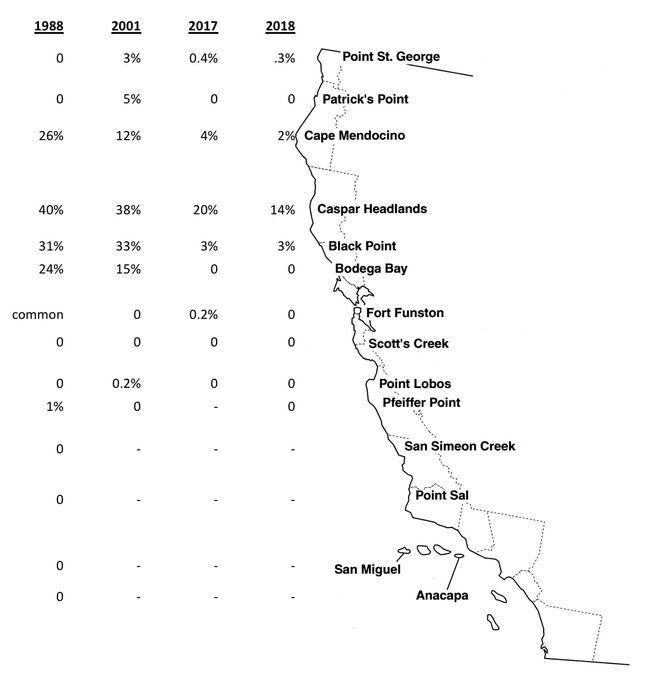
A graphic from the UC Davis researchers' article in the journal Ecology.
Bristly Oxtongue Lives Up to its Name
This summer, you may have noticed what looks like a large dandelion plant covered in blisters...
Honey Bee Day Reminds us to Protect Bees Year-Round
Saturday, August 18 is National Honey Bee Day! Many people are concerned about the health of honey...



